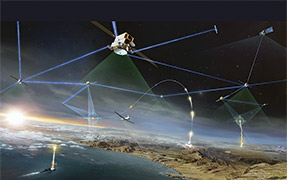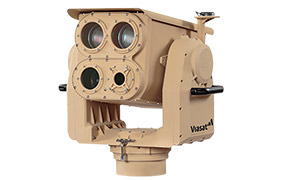Optics Rock Star
"Professor Daniel Malacara-Hernández is a Mexican optics rock star,” says Eric Rosas, scientific coordinator at the Centro Nacional de Metrología (Mexico).
Rosas first met Malacara-Hernández at the start of his doctoral courses at the Centro de Investigaciones en Óptica (CIO) in 1994. About 7 am on a Monday, Rosas and 14 other doctoral students were waiting in the lobby for their 8 am lecture with Malacara-Hernández, one of the founders of the CIO. To the students’ surprise, Malacara-Hernández walked into the lobby, introduced himself (as if that were necessary, Rosas notes), and began speaking with each of the students. He spent the entire hour getting to know them and talking about his own history in optics research.
Just before 8 am, Malacara-Hernández said, “OK guys. Thank you very much for your time and friendly talk this morning. It is now time for me to start with my daily labor and for you to start with your PhD lectures. I wanted to arrive early today to meet every one of you in person because to me, every young student interested in optics is a very important person.”
Rosas says he immediately understood that Malacara-Hernández “was not only an extraordinarily good optics scientist, but also a better human being.”
Malacara-Hernández was born in Leon, Guanajuato, Mexico. The eldest of eight children, he developed an interest in physics as a young child — particularly optics and electronics.
This interest was kindled by his father, Zacarías Malacara, who although not academically trained, had a knack for technology and invention. As an adult, Malacara-Hernández encouraged his father to study optics and Malacara eventually opened a business making ophthalmic lenses assisted by his eldest son.
By age 15, Malacara-Hernández was experimenting with ham radio and building his own shortwave radio transmitters. Already honing his skills in optics, he also built several reflecting telescopes with varying diameters and microscopes with different lens configurations copied from books provided by his father.
After high school, Malacara-Hernández attended the Universidad Nacional Autónoma de México (UNAM) in Mexico City where he studied astronomy under a young Arcadio Poveda, the Mexican astronomer who would develop a method for calculating the mass of elliptical galaxies. Poveda convinced Malacara-Hernández that his true interest was in optics, not astronomy.
At that time, no Mexican universities offered graduate degrees in optics. Poveda pointed out that if Malacara-Hernández achieved a PhD in optics, he would be the first Mexican to do so.
To complete his BS thesis at UNAM, Malacara-Hernández worked for several months on a lens design and fabrication project at the Kitt Peak National Observatory (USA) under the guidance of the late American astronomer Aden B. Meinel. (Meinel and his wife Marjorie, received the SPIE Gold Medal in 1997.)
At the end of the project, Meinel recommended Malacara-Hernández attend the University of Rochester (UR), which at the time, was the only American university with a specialty in optics. He received both his MS and PhD in optics at UR with the help of several friends and mentors, including Emil Wolf, and the late Rudolf Kingslake and Robert E. Hopkins.
“They gave me so many good things that I will never be able to repay,” Malacara-Hernández says. “I am still extremely grateful to all of them.”
During his time at UR, Malacara-Hernández began dreaming of developing an optics institute in Mexico that would be on par with UR’s Institute of Optics.
In 1972, Malacara-Hernández was named technical director and professor at the Instituto Nacional de Astrofísica Optica y Electrónica (INAOE) in Tonantzintla, Puebla. Two years earlier, Malacara-Hernández had been invited by astronomer Guillermo Haro to help redesign and upgrade the Observatorio Astrofísico de Tonantzintla, founded in 1942, which became the INAOE.

Part of the development of the INAOE included offering an MS degree in optics, the first in Mexico. Another project was to design and construct the optics for a 2.1-meter-diameter astronomical telescope, the largest telescope in Latin America at the time.
“This project was wonderful for us,” Malacara-Hernández says. “It gave us the opportunity to become heavily involved not only in optical manufacturing, but also in optical testing.
“We realized the need for a good book in this subject. I invited some of my friends, specialists in this field, to collaborate with me as contributing authors in a project to write the book, Optical Shop Testing.”
Now in its third edition, Optical Shop Testing has been translated into several languages and is used as a textbook and reference in universities and optics laboratories around the world.
By 1979, the INAOE projects were running successfully, and Malacara-Hernández received a call from his old friend Arcadio Poveda — then at UNAM — to say that rector Guillermo Soberón Acevedo was leading a project to found new research centers in several locations throughout Mexico. This was an opportunity to propose the creation of an institution dedicated solely to optics as Malacara-Hernández had dreamed.
Malacara-Hernández proposed his hometown Leon as the place to start this new institution. Assistance came from the governor of Guanajuato and the mayor of Leon, both of whom were childhood friends of Malacara-Hernández. They offered to collaborate on finding the right property for the institution, and the CIO opened in April 1980.
As general director of the CIO, Malacara-Hernández was in charge of one of the first and most successful scientific institutions outside of Mexico City where most technological development was happening.
“Daniel Malacara-Hernández was crucial in the development of the research and academic courses in CIO,” says SPIE Fellow and past SPIE President María Yzuel of the Universidad Autónoma de Barcelona (Spain). “Daniel has trained many of the professors and researchers who are at the CIO or in other centers in Mexico. Today he is widely recognized by the international optics community for his research in several fields of optics and even more for his contributions in optical metrology.”
Still the humble person Rosas met in 1994, Malacara-Hernández is grateful and happy to win the SPIE Gold Medal for 2012.
“I have been a very fortunate person,” he says. “Many people have helped and supported me in my life. My parents and brothers and sisters since the beginning, and also my wonderful wife and children. Without the support of my mentors, colleagues, and collaborators, nothing could have been done.
“To me, the SPIE Gold Medal recognizes the virtues of collaboration, which I have had all my life with many friends. Really, this medal should be awarded to all of them. Naturally, it gives me pleasure, but also I feel a great responsibility.”
 The Gold Medal, the highest honor the Society bestows, recognizes Malacara-Hernández’ many contributions to the field of optics through research, publications, and the establishment of institutes devoted to teaching and research in optics. Malacara-Hernández will formally accept the award in August at SPIE Optics + Photonics.
The Gold Medal, the highest honor the Society bestows, recognizes Malacara-Hernández’ many contributions to the field of optics through research, publications, and the establishment of institutes devoted to teaching and research in optics. Malacara-Hernández will formally accept the award in August at SPIE Optics + Photonics.
Mexico’s INAOE
The National Institute of Astrophysics, Optics, and Electronics (INAOE) is a physical science research institute located in Tonantzintla, Puebla, Mexico.
Founded by presidential decree in 1971, the original mission of the INAOE was the development, improvement, and distribution of scientific knowledge by identifying and solving scientific problems and training specialists in the areas of astrophysics, optics, electronics, and computational sciences.
With a staff of over 100 researches and lecturers in these four disciplines, the INAOE has become one the most important research institutes in Mexico. INAOE is one of 30 public research centers sponsored by the National Council of Science and Technology of Mexico (CONACyT).
The institute, in partnership with the University of Massachusetts at Amherst, developed the Large Millimeter Telescope/Gran Telescopio Milimétrico on the Puebla-Veracruz border.
Centro de Investigaciones en Óptica
The Centro de Investigaciones en Óptica (CIO) occupies a core position in the development of science and technology in Mexico.
Founded in 1980 in Leon, Guanajuato, Mexico, the center is dedicated to researching problems in areas such as optical design and engineering, holography, interferometry, nanomaterials, terahertz, and photonics crystals.
The CIO is currently defined as a public research center. Its mission is to conduct basic and applied research, to generate top-level human resources in optics, and foster scientific culture within society.
The CIO is considered a Research Center of Excellence with national leadership and international recognition in the field of optics.
Have a question or comment about this article? Write to us at spieprofessional@spie.org.
To receive a print copy of SPIE Professional, the SPIE member magazine, become an SPIE member.



